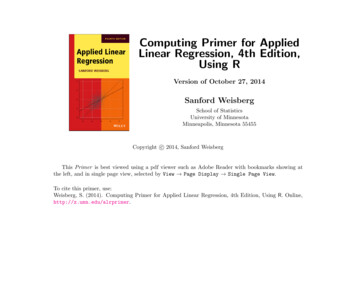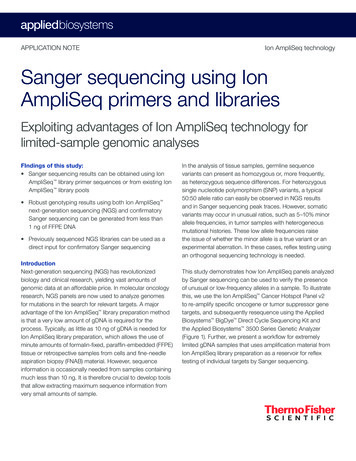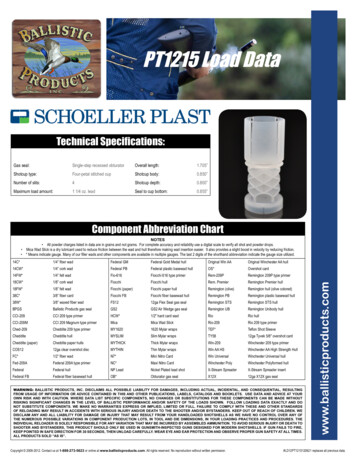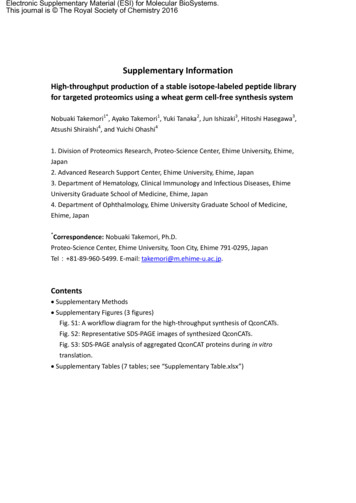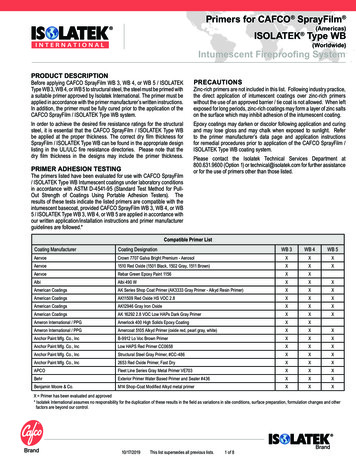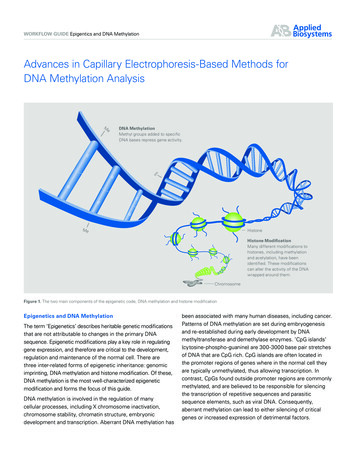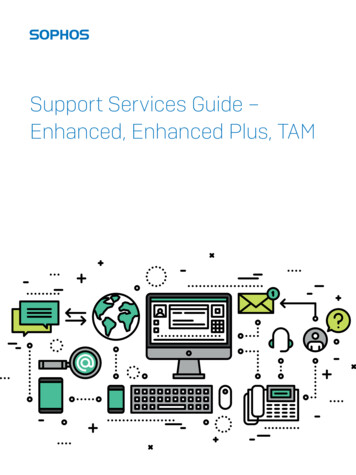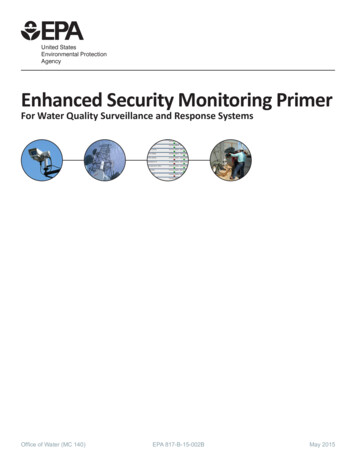
Transcription
United StatesEnvironmental ProtectionAgencyEnhanced Security Monitoring PrimerFor Water Quality Surveillance and Response SystemsOffice of Water (MC 140)EPA 817-B-15-002BMay 2015
Enhanced Security Monitoring PrimerIntroductionA Water Quality Surveillance and Response System (SRS) provides a systematic framework forenhancing distribution system monitoring activities to detect emerging water quality issues and respondbefore they become problems. An SRS consists of six components grouped into two operational phases,surveillance and response. The surveillance components are designed to provide timely detection ofwater quality incidents in drinking water distribution systems and include: Online Water QualityMonitoring, Enhanced Security Monitoring, Customer Complaint Surveillance and Public HealthSurveillance. The response components include Consequence Management and Sampling & Analysis,which support timely response actions that minimize the consequences of a contamination incident. TheWater Quality Surveillance and Response System Primer provides a complete overview (USEPA, 2015).This document provides an overview of Enhanced Security Monitoring (ESM),a surveillance component of an SRS. It presents basic information about thegoals and objectives of ESM in the context of an SRS. This primer covers thefollowing four topics: Topic 1: What is ESM? Topic 2: What are the major design elements of ESM? Topic 3: What are common design goals and performance objectivesfor ESM? Topic 4: What are cost-effective approaches for ESM?Topic 1: What is ESM?ESM utilizes physical security equipment at key distribution system facilities to detect unauthorizedentries that could lead to a contamination incident. ESM equipment can also be effective for detectingvandalism and theft. Furthermore, video monitoring systems used for ESM can provide operationalbenefits by allowing utility staff to view process equipment and conditions at remote facilities without asite visit.Figure 1 is a schematic representation of ESM. Intrusion detection is provided by equipmentstrategically located at a utility facility. Alerts generated are transmitted by a reliable communicationsystem, and personnel are notified of the alerts through emails, mobile devices or display at a centralcontrol facility. ESM investigations are guided by documented procedures and coordinated with externalagencies such as local law enforcement.Figure 1. Schematic Representation of ESM1
Enhanced Security Monitoring PrimerTopic 2: What are the major design elements of ESM?The major design elements for ESM are shown in Figure 2 and described under the remainder of DigitalVideo RecorderCommunicationSCADADigitalCellularRadioHigh SpeedWired Data resMobile DeviceCentral ControlCenterOther RemoteLocationsFigure 2. ESM Design ElementsIntrusion Detection EquipmentThe Intrusion Detection Equipment design element focuses on selecting facilities for securityenhancements and proposing equipment for each selected facility. The facility and equipment selectionprocess can use a risk-based methodology such as the Vulnerability Self-Assessment Tool, which iscompliant with the J100 industry standard. This process assesses the threat of, vulnerability to andconsequence of attacks at each facility under consideration and evaluates the overall reduction in riskprovided by ESM enhancements. This analysis provides a quantitative basis for selecting facilities andequipment for ESM.The deployment of intrusion detection equipment isat the core of the ESM component. The ability ofESM equipment to detect intrusions depends on theplacement, number and types of intrusion detectionsensors and video cameras. Physical securityequipment is continuously improving as sensingtechnology advances, with equipment becomingless expensive, more reliable and moreconfigurable. These advances provide for broadercoverage with fewer invalid alerts and have allowedutilities with limited resources to implement realtime security monitoring at remote utility facilities.DID YOU KNOW?The EPA’s Vulnerability Self-Assessment Tool(VSAT) is a J100 standard compliant riskassessment software tool for water, wastewaterand combined utilities of all sizes.The tool assists drinking water and wastewaterfacility owners and operators in performingsecurity threat and natural hazard riskassessments, as well as updating utilityEmergency Response Plans. (EPA, 2013).2
Enhanced Security Monitoring PrimerESM equipment can be divided into two general categories: Intrusion Detection and Video Surveillance.Examples of each category are illustrated in Table 1.Table 1. ESM EquipmentVideo SurveillanceIntrusion DetectionEquipment TypesDescriptionDoor and hatch sensorsContact switches such as magnetic proximity andmechanical limit typesUsed at site access points (for example, on doors,windows or hatches)Motion sensorsUsed for site or interior area coverage (for example, alonga row of windows)Fence-mounted sensorsBuried-line sensorsUsed for disturbance sensing (for example, taut wires andmagnetic field sensors)Used for perimeter security (for example, near fencing)Internet protocol camerasConverts images into digital dataInfrared camerasUsed for outdoor or low light conditionsEvent-based network or digital video recordersTransmits video clips on demand and stores video dataVideo analyticsAlgorithms embedded in video software to detect static(loitering or unattended items) or dynamic (walking orrunning) situations captured by monitoring camerasCommunicationsThe Communications design element consists of systems that transmit ESM alert information fromfacility intrusion detection equipment to a central control facility. The communications infrastructuremust be capable of supporting the required data speed (bandwidth) such that ESM alert information canbe transmitted to the central control facility in a timely manner. Data speed requirements will varygreatly depending on whether the system includesvideo data and how the video monitoring system isDID YOU KNOW?configured to transmit data.Information ManagementOnce the data is delivered to the central controlfacility, it should be displayed on a user interfacethat allows utility staff to quickly recognize andrespond to the alert. Furthermore, ESM alertinformation must be stored and accessible for postincident analysis. Information technologyarchitecture configurable by system administratorsis a standard approach.A useful resource for ESM is the Guidelines forthe Physical Security of Water Utilities /Guidelines for the Physical Security ofWastewater/Stormwater Utilities (ASCE/AWWA,2011), a collaborative publication from theAmerican National Standards Institute, AmericanSociety of Civil Engineers (ASCE), AmericanWater Works Association (AWWA), and WaterEnvironment Federation. This document isavailable for purchase from ASCE.For both the Communications and Information Management design elements, leveraging existing networkand communications infrastructure can reduce the cost of equipment and installation. When designingthese elements of the system, consideration should also be given to in-house capabilities andcompatibility with existing equipment.3
Enhanced Security Monitoring PrimerAlert Investigation ProceduresESM alerts need to be promptly investigated by utility personnel to determine whether or not the potentialintrusion might be related to drinking water contamination. The following are basic example steps thatmay be performed during ESM alert investigations.1. An ESM investigation begins after utility staff receives an intrusion alert.2. Utility personnel use a checklist to guide them through a predetermined investigation procedureto determine whether the intrusion could disrupt utility operations or present a risk ofcontamination. The checklist may guide actions such as:a. Assessing known activity at the facility, such as maintenance by utility personnel orcontractorsb. Assessing video, if available, to verify the intrusion incidentc. Notifying and dispatching investigators to physically inspect the facility where the alertoriginated3. If definitive video evidence is not available, an investigation is conducted to verify or rule out theintrusion and determine whether there wasaccess to the finished water supply.DID YOU KNOW?4. If the investigation determines that the alertInvalid alerts associated with procedural errorswas not caused by unauthorized activity, theare common and often caused by employeesinvestigation is closed and logged.who forget to call in when accessing amonitored facility or forget to completely close5. If the investigation verifies an intrusion withall monitored doors when leaving the facility.access to the finished water, the investigationEquipment and environmentally-caused invalidcontinues according to procedures in thealerts are less common.drinking water utility’s ConsequenceManagement Plan.Topic 3: What are common design goals and performance objectivesfor ESM?The design goals and performance objectives established for ESM by the utility provide the basis for thedesign of an effective component.ESM Design GoalsDesign goals are the specific benefits that utilities expect to achieve by implementing ESM. Afundamental design goal of an SRS is the ability to detect and respond to possible distribution systemcontamination incidents. In addition to this fundamental SRS design goal, other ESM-specific designgoals such as detecting theft, vandalism and sabotage incidents can be realized. Examples of commonESM design goals are listed in Table 2.4
Enhanced Security Monitoring PrimerTable 2. Examples of Common ESM Design GoalsDesign GoalDescriptionIdentify intrusion incidents thatcould lead to water contaminationESM can provide early warning of contamination incidents that could harmpublic health or utility infrastructure, which can trigger response actions tominimize consequences. In some cases, ESM may even preempt watercontamination if the perpetrator is caught in the act.Deter, detect and respond to theft,vandalism and sabotageESM systems can detect all types of intrusion incidents including thosewhere contamination is not the intent of the intruder. Such criminal activitymay not have a significant impact on public health, but can place utilitystaff at-risk and impact a utility’s operating budget and day-to-daymaintenance activities.Remote monitoring of processequipmentIf ESM includes video monitoring, operational benefits can be realized if theESM cameras can also be used to monitor process equipment at unstaffedfacilities. For example, pumps can be observed for malfunctions andintake structures can be monitored for the build-up of debris. Videomonitoring can reduce the amount of travel time and on-site inspectionsrequired, thus reducing utility labor costs.Increased collaboration within theutility and with local lawenforcementCollaboration with law enforcement during water utility drills and exercisescan lead to improved coordination during response to real-worldemergencies. Also, an ESM camera with a field of view of a public areacan support law enforcement investigations unrelated to a water incident.Improved response decisionmakingDeveloping ESM procedures can streamline and standardize a utility’sdecision-making process when investigating an intrusion incident. Thus,procedural improvements can enhance a utility’s overall preparedness andresponsiveness to physical security alerts.ESM Performance ObjectivesPerformance objectives are measurable indicators of how well the SRS meets the design goals establishedby the utility. Throughout design, implementation and operation of the SRS or its components, the utilitycan use performance objectives to evaluate the added value of each capability, procedure or partnership.While specific performance objectives should be developed by each utility in the context of its uniquedesign goals, general performance objectives for an SRS are defined in the Water Quality Surveillanceand Response System Primer (USEPA, 2015) and are further described in the context of ESM as follows. Incident coverage: Detect and respond to a broad spectrum of water quality incidents. One ofthe primary focuses of ESM is deploying intrusion detection sensors and video monitoringequipment to reduce the risk of contamination at select sites. The intent of such equipment is tomonitor all areas that provide access to finished water, and detect all intrusions that could lead toa contamination incident. ESM design goals may also include detection of vandalism and theft,which could require monitoring of areas that do not provide access to finished water. Spatial coverage: Achieve spatial coverage of the entire distribution system. ESM is limited inits ability to detect contamination incidents throughout the distribution system because onlyspecific utility facilities are monitored for intrusions. However, utility facilities are chosen forESM equipment based on their overall risk of contamination and the amount of risk reduction thatwould result from such enhancements. Thus the sites selected for enhancements can have thepotential to impact a large portion of the distribution system and general population. Timeliness of detection: Detect water quality incidents in sufficient time for an effectiveresponse. Utility staff must be immediately alerted of intrusions and investigate alerts in a timelymanner. To meet this objective, alerts from remote facilities must be transmitted to the centralcontrol facility without delay. ESM also includes procedures for initiating and conducting aninvestigation in a timely manner. With a rapid response, it may be possible for the ESMcomponent to prevent a contamination incident from occurring.5
Enhanced Security Monitoring Primer Operational reliability: Minimize downtime for equipment, personnel and other supportfunctions necessary for the component to meet the other performance objectives. One of thecriteria for selecting intrusion detection equipment and information management systems shouldbe reliability. In many cases, selecting a more reliable device that is more expensive can savemoney over its lifecycle when compared to a less expensive device requiring more maintenance.Alert occurrence: Reliably indicate unauthorized intrusions with a minimum number of invalidalerts. When implementing ESM enhancements, proper commissioning is recommended toensure that each intrusion sensor is sensitive enough to detect intrusions with at least a 95 percentconfidence level, but not overly sensitive and prone to an unacceptable number of invalid alerts.Sustainability: Realize benefits that justifyDID YOU KNOW?the costs and level of effort required toimplement and operate ESM. Benefits areUtilities may be able to make modest changes oradditions to existing physical securityrealized through attainment of the designcapabilities to implement their ESM component.goals for ESM. The AWWA’s J100 RiskAnalysis and Management for Critical AssetProtection Standard can be consulted for quantifying non-quantifiable benefits of securityenhancements (ANSI/ASME-ITI/AWWA, 2010). Costs should be considered over the lifecycleof the component, including implementation costs, operation and maintenance costs, and renewaland replacement costs.Topic 4: What are cost-effective approaches for ESM?Utilities can take the following simple steps to develop the foundation for ESM: Rank major utility facilities with respect to the risk of contamination. At the facilities determined to have the greatest risk, add simple, inexpensive intrusion sensors,such as contact alarms on doors and hatches. Use existing communications to transmit ESMalerts if possible. Establish procedures for the joint utility and law enforcement investigation of ESM alerts thatmight be indicative of contaminated drinking water.Next StepsVisit the Water Quality Surveillance and Response Website at lawsregs/initiative.cfm for more information about SRS practices. The Website containsguidance and tools that will help a utility to enhance surveillance and response capabilities, as well ascase studies that share utility experiences with SRS implementation and operation.ReferencesANSI, ASME-ITI and AWWA. (2010). Risk Analysis and Management for Critical Asset Protection(RAMCAP ) Standard for Risk and Resilience Management of Water and Wastewater Systems.AWWA J100-10. Denver, CO.ASCE and AWWA. (2011). Guidelines for the Physical Security of Water Utilities (56-10) andGuidelines for the Physical Security of Wastewater/Stormwater Utilities (57-10). Denver, CO.USEPA. (2013). Vulnerability Self Assessment Tool (VSAT). Retrieved n/VSAT.USEPA. (2015). Water Quality Surveillance and Response System Primer, 817-B-15-002.6
Water Quality Surveillance and Response System Primer provides a complete overview (USEPA, 2015). This document provides an overview of Enhanced Security Monitoring (ESM), . Algorithms embedded in video software to detect static (loitering or unattended items) or dynamic (walking or running) situations captured by monitoring cameras .

